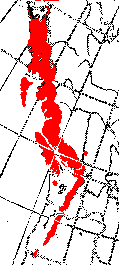
Range map (7).
Common Names
Alaska yellow-cedar, Alaska cedar, yellow cypress (3, 4), Nootka cypress, Alaska cypress.Taxonomic notes
Syn: Cupressus nootkatensis D. Don in Lambert 1824 (5); recent studies suggest a return to this nomenclature (11, 12)."In addition to variation in habit within the species, occasional plants have divergent forms of foliage. In light of the foliar and habit phenotypes recognized in the horticultural literature (for example, A. J. Rehder [1949] listed, with full bibliographic citations, 22 published varieties and forms best considered as cultivars), no taxonomic significance is attached to this variation here" (5).
Description
Trees to 40 m or dwarfed at high elevations; trunk to 200 cm dbh. Bark grayish brown, 1-2 cm thick, irregularly fissured. Branchlet sprays pinnate. Leaves of branchlets mostly 1.5-2.5 mm, stout, occasionally glandular on keel, apex rounded to acute or acuminate, bases of facial leaves often overlapped by apices of subtending facial leaves; glands usually absent (circular when present). Pollen cones 2-5 mm, grayish brown; pollen sacs yellow. Seed cones maturing and opening the second year, rarely in some southern lowland populations late in the first year, in (10-)16-18 months (6, 13), 8-12 mm broad, glaucous, dark reddish brown, becoming resinous; scales 4-6, valvate with an open apex; a small central columella between the apical pair of scales. Seeds 2-4 per scale, 2-5 mm, wing equal to or broader than body (5, 14).Range
USA, Canada: Pacific Coast area from S and SE Alaska through British Columbia, Washington and Oregon to extreme NW California; locally found farther inland; at 600-2100 m in the S, to sea level in the N (4). Disjunct inland populations occur in BC and OR (Krajina et al. 1982) (5). Usually found on mesic to hygric sites including avalanche chutes, snowy timberlines, and bog-forest transition areas (3). Although it usually occurs in mixed conifer forests (most often with Tsuga mertensiana ), it occasionally forms pure stands (8). See also (16). USDA hardiness zone 6.Big Tree
Diameter 416 cm, height 61.0 m, located in Kelsey Bay, Vancouver Island, BC (2).Oldest
1834 years for a specimen from the Caren Range, Sechelt Peninsula, BC, collected by M.L. Parker (2). 1636 years for a specimen from Vancouver Island collected by L. Jozsa (9). Both ages represent ring counts from stumps in clearcuts. It is to be hoped that comparably old trees remain uncut.Dendrochronology
Has been studied to date periods of bark harvesting by native peoples and to determine stand ages. Generally has poor circuit uniformity and low sensitivity, so of limited use in dendroclimatic studies. See (15).Ethnobotany
The tough, straight-grained wood was used by nearly all Northwest Coast peoples for bows, canoe paddles, ceremonial masks, chests, dishes, digging sticks, adze handles, and fish net hoops. The bows were a popular trade item, sometimes traded well beyond the species' range. Branch tips and green cones were used medicinally. In folklore, the tree was believed to have once had human form (3).Modern society uses the wood for furniture, finish carpentry, and boats (8).
The hybrid of this species with Cupressus macrocarpa (Leyland cypress, Cupressus [Cupressocyparis] x leylandii ), is of major horticultural importance, particularly in Britain where it arose about 100 years ago. It accounts for 99.5% of the suburban hedge plant market there, despite being far too vigorous for this purpose, growing at 0.5-0.8 m per year to 35 m or more if not trimmed frequently. Two other hybrids, with Cupressus arizonica var. glabra and Cupressus lusitanica , are also known in cultivation, but are not widely planted. It has never been hybridised with any Chamaecyparis species (14).
Observations
Common in high montane and subalpine forests of the Cascade Range, Washington and Oregon. Some pure old-growth stands are found in Mt. Rainier National Park, and it is codominant with Tsuga mertensiana near timberline at Jefferson Park, Mt. Jefferson Wilderness, Oregon.Remarks
The crushed foliage and freshly cut wood has a rather rank odor, similar to several Cupressus and Juniperus species, and quite unlike the other Chamaecyparis species.Citations
(1) Silba 1986 .(2) E-mail communication from Robert Van Pelt, who measured the big tree; 18-Mar-1998.
(3) Pojar & Mackinnon 1994 .
(4) Peattie 1950 .
(5) David C. Michener at the Flora of North America web site .
(6) Owens & Molder 1975 .
(7) Burns & Honkala 1990 .
(8) Little 1980 .
(9) Brown 1996 .
(11) H.J. Welch. 1991. The Conifer Manual vol. 1.
(12) M.P. Frankis. 1993. Nootka Cypress: Chamaecyparis or Cupressus? Conif. Soc. Austral. Newsletter 12: 9-10.
(13) Y.A. El-Kassaby et al. 1991. Reproductive-cycle plasticity in yellow-cedar. Canadian Journal of Forest Research 21: 1360-1364.
(14) Personal observations reported by M.P. Frankis, 5-Feb-1999.
(15) Laroque, C., Smith, D.J. 1999. Tree-ring analysis of yellow-cedar (Chamaecyparis nootkatensis) on Vancouver Island, British Columbia. Canadian Journal of Forest Research 29: 115-123.
(16) Robert S. Thompson, Katherine H. Anderson and Patrick J. Bartlein. 1999. Atlas of Relations Between Climatic Parameters and Distributions of Important Trees and Shrubs in North America. U.S. Geological Survey Professional Paper 1650 A&B. URL= http://greenwood.cr.usgs.gov/pub/ppapers/p1650-a/pages/conifers.html, accessed 22-Jan-2000.
See also:
Grescoe, A. and B. Herger. 1997. Giants: the colossal trees of Pacific North
America. Boulder, CO: Roberts Rinehart.
This page edited with the help of M.P. Frankis, Feb-1999.
back | Chamaecyparis | Cupressaceae | home
This page is from the Gymnosperm Database
URL: http://www.geocities.com/~earlecj/cu/ch/nootkatensis.htm
Edited by Christopher J. Earle
E-mail:
earlecj@earthlink.com
Last modified on 22-Jan-2000